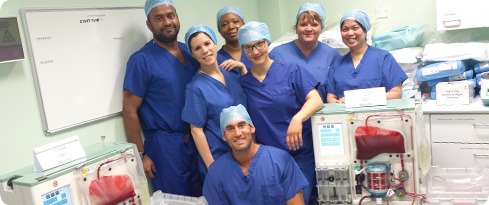Your views

Your feedback is vital to us as we continue to increase the quality of our services.
You are here:
Date: 27 January 2025
Time: 17:13

Transplant procedure hailed “exciting development”
Story posted/last updated: 21 January 2019
Thanks to the work of the Liver Transplant Research team at University Hospitals Birmingham NHS Foundation Trust (UHB) and the University of Birmingham, a procedure now assessed by the National Institute for Health and Care Excellence (NICE), has been hailed as an “exciting development” in increasing the number of livers which can be safely used for transplantation.
A perfusion machine can keep the donated liver viable for transplantation for longer. The machine reduces the rate of tissue deterioration that occurs after the liver has been removed from the donor and extends how long the liver can be stored before transplantation.
Variations of the technique can also allow the liver to be flushed with blood at body temperature and supplied with oxygen, medications and nutrients allowing its viability and function to be assessed.
It is hoped machine perfusion could increase the number of organs viable for transplant, saving more lives and reducing liver transplant waiting lists.
Liver transplantation is a highly successful treatment for end-stage liver disease, which kills 11,000 people a year in England. Deaths from liver disease have soared by 25% in a decade and continue to rise, while the average age of death from liver disease (currently 50 – 59 years) continues to decrease.
On Wednesday 16 January 2019, NICE issued final guidance which recommends the procedure – ex-vivo machine perfusion for extracorporeal preservation of livers for transplantation – is used under special arrangements as more data is gathered into its efficacy.
Darius Mirza, Professor of Hepatobiliary and Transplant Surgery at UHB, said: "In the 30 years I've been involved with transplantation there have been three or four events which have been game changers and I'm absolutely certain we are looking at a game changer that will change the way we practice organ storage and transplantation.
"It is already changing practice at the centres that have been able to use this technology either within clinical trials or within an expansion of service evaluation."
Surgeons undertaking the procedure must inform patients about the uncertainty of the procedure’s efficacy, comply with the relevant regulatory and legal requirements of the Human Tissue Authority and should enter details about all patients having this procedure into the NHS Blood and Transplant (NHSBT) UK transplant registry.
Professor Kevin Harris, Programme Director and Clinical Advisor for the Interventional Procedures Programme at NICE, said: “This procedure offers hope for patients needing a liver transplant. It offers another way of preserving the liver, and assessing whether livers which might have previously been considered unsuitable, can be used safely.
“The latest evidence reviewed by a NICE committee concluded that the procedure worked well and was safe to be offered to patients who had been fully informed of the risks and benefits. Clinicians should seek approval from their trust’s management and record all data from the procedure in a database.
“By using this procedure, more patients on the organ transplant waiting list could be offered a chance of a transplant and there-by potentially extending their lives.”
Sue Bennett, 45, a mother of three from Ranton in Staffordshire, had a liver transplant using this new technique in 2015. She said: “I signed up for the trial not knowing I would be one of the first to have this procedure in the country. Before my transplant I was very ill. I was losing weight, I couldn’t sleep and my quality of life was quite low.
“I had a transplant after the hospital found a donor who was a match. The liver was kept alive using this procedure overnight and I was able to have the operation the following day. Nine days later I was back home.
“Having a transplant has changed my life. I‘ve joined the gym, got fit and gone back to work and did some voluntary work for the Staffordshire Search and Rescue team and I also compete nationally and internationally in the Transplant Games as a member of the Team GB transplant team.
“My life is unbelievably wonderful. I’m very healthy, I’m very happy and very active. I think I‘ve been very lucky.”
John Forsythe, Associate Medical Director at NHSBT, said: “There has been a huge amount of research in the area of preservation and perfusion methods that allow us to both assess precious donor organs and to enhance their function. This could potentially mean the organ works better and improve transplant outcomes.
“Many of the lead researchers in the area of transplant preservation and perfusion techniques are in the UK and it is good to see UK researchers continue to be at the forefront in this field. Transplantation wouldn’t be possible without the generosity of organ donors and their families.”
NHS England and commissioners will decide whether they fund the procedure. However research is already taking place at the University of Birmingham and Queen Elizabeth Hospital Birmingham and other transplant centres across the country.
For the financial year ending 31 March 2018, there were 1,043 liver transplants in the UK and 359 patients on the UK active transplant list, according to NHSBT.
The number of patients on the active transplant list reached a ten year high in 2015 when 611 patients were on the waiting list. However the large drop attributed to the 2018 figure may be due to the introduction of the National Liver Offering Scheme (NLOS) in March 2018.
Related pages

Getting here
Information about travelling to, staying at and getting around the hospital.

Jobs at UHB
A great place to work. Learn why.
news@UHB


RSS feed
Subscribe to our news feed


